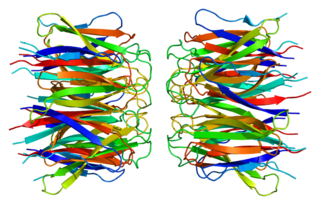Ubiquitin is a protein that in humans is encoded by the UBB gene. [5]
Ubiquitin is a protein that in humans is encoded by the UBB gene. [5]
Ubiquitin is one of the most conserved proteins known in eukaryotic organisms. Ubiquitin is required for ATP-dependent, non-lysosomal intracellular protein degradation of abnormal proteins and normal proteins with a rapid turnover. Ubiquitin is covalently bound to proteins to be degraded, and presumably labels these proteins for degradation. Ubiquitin also binds to histone H2A in actively transcribed regions but does not cause histone H2A degradation, suggesting that ubiquitin is also involved in regulation of gene expression. This gene consists of three direct repeats of the ubiquitin coding sequence with no spacer sequence. Consequently, the protein is expressed as a polyubiquitin precursor with a final amino acid after the last repeat. Aberrant form of this protein (UBB+1) has been noticed in patients with Alzheimer's disease, Down syndrome, other tauopathies (e.g. Pick's disease) and polyglutamine disease (e.g. Huntington's disease). [6] [7]

Ubiquitin is a small regulatory protein found in most tissues of eukaryotic organisms, i.e., it is found ubiquitously. It was discovered in 1975 by Gideon Goldstein and further characterized throughout the late 1970s and 1980s. Four genes in the human genome code for ubiquitin: UBB, UBC, UBA52 and RPS27A.

Nucleophosmin (NPM), also known as nucleolar phosphoprotein B23 or numatrin, is a protein that in humans is encoded by the NPM1 gene.

Histone H3.1 is a protein that in humans is encoded by the H3C2 gene.

Myocyte-specific enhancer factor 2A is a protein that in humans is encoded by the MEF2A gene. MEF2A is a transcription factor in the Mef2 family. In humans it is located on chromosome 15q26. Certain mutations in MEF2A cause an autosomal dominant form of coronary artery disease and myocardial infarction.

Histone H2A.Z is a protein that in humans is encoded by the H2AZ1 gene.
Histones are basic nuclear proteins that are responsible for the nucleosome structure of the chromosomal fiber in eukaryotes. Nucleosomes consist of approximately 146 bp of DNA wrapped around a histone octamer composed of pairs of each of the four core histones. The chromatin fiber is further compacted through the interaction of a linker histone, H1, with the DNA between the nucleosomes to form higher order chromatin structures. The H2AFZ gene encodes a replication-independent member of the histone H2A family that is distinct from other members of the family. Studies in mice have shown that this particular histone is required for embryonic development and indicate that lack of functional histone H2A leads to embryonic lethality.

40S ribosomal protein S27a is a protein that in humans is encoded by the RPS27A gene.

60S ribosomal protein L40 (RPL40) is a protein that in humans is encoded by the UBA52 gene.

Splicing factor, arginine/serine-rich 3 is a protein that in humans is encoded by the SFRS3 gene.

Histone H4 is a protein that, in humans, is encoded by the HIST1H4I gene.

Histone H2B type 1-J is a protein that in humans is encoded by the HIST1H2BJ gene.

Histone H2B type 1-K is a protein that in humans is encoded by the HIST1H2BK gene.

Histone H1.5 is a protein that in humans is encoded by the HIST1H1B gene.

Non-histone chromosomal protein HMG-17 is a protein that in humans is encoded by the HMGN2 gene.

Zinc finger protein Gfi-1 is a transcriptional repressor that in humans is encoded by the GFI1 gene. It is important normal hematopoiesis.

Methylosome protein 50 is a protein that in humans is encoded by the WDR77 gene.

Ubiquitin-conjugating enzyme E2 variant 1 is a protein that in humans is encoded by the UBE2V1 gene.

Histone H2A type 1-B/E is a protein that in humans is encoded by the HIST1H2AB gene.

Spermatid nuclear transition protein 1 is a protein that in humans is encoded by the TNP1 gene.

DNA polymerase epsilon subunit 3 is an enzyme that in humans is encoded by the POLE3 gene.

Protein phosphatase 1G is an enzyme that in humans is encoded by the PPM1G gene.